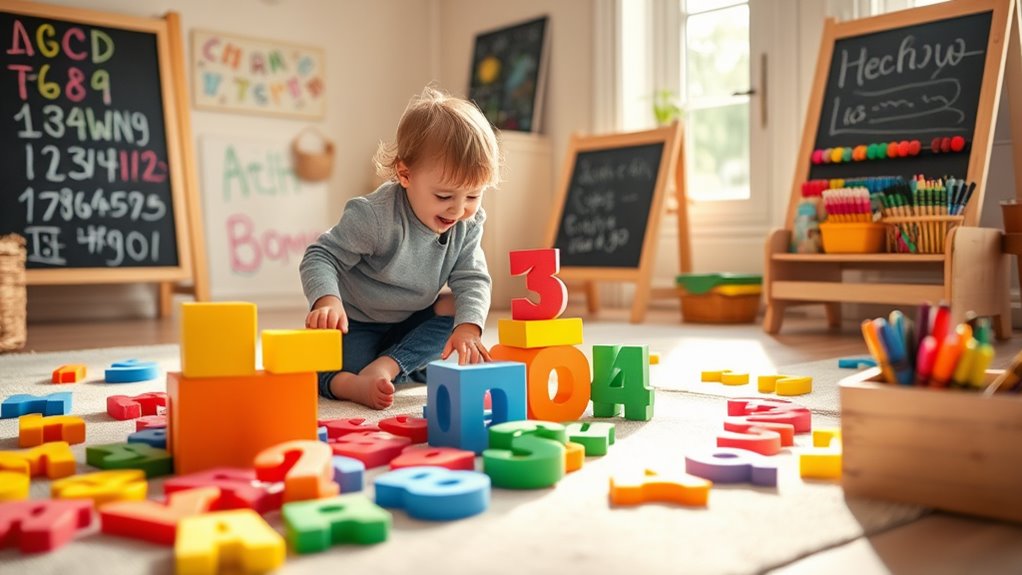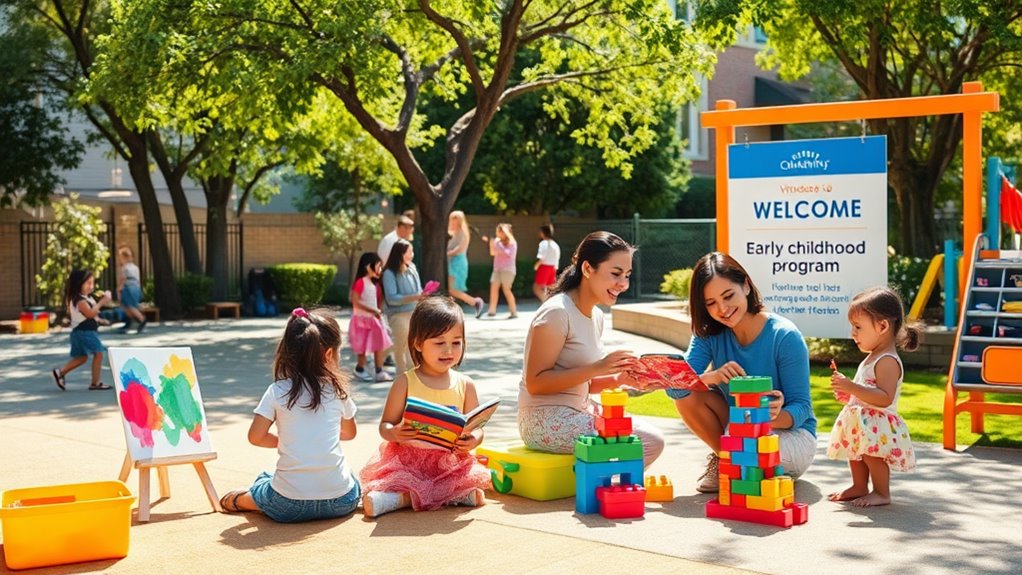5 Creative Ways to Teach Your Toddler Letters and Numbers
You can make teaching your toddler letters and numbers a fun experience with some creative methods. Start with a playful letter scavenger hunt around your home, using colorful cards as treasures. Engage them in interactive number art projects, like creating collages or puppets. Storytime can spark excitement with alphabet books that highlight letters and sounds. Don’t forget musical learning—catchy tunes can help reinforce recognition. Finally, introduce sensory play with bins filled with sand or rice, hiding letters and numbers for a tactile exploration. Keep going, and you’ll discover even more engaging ways to enhance their learning journey!
Key Takeaways
- Organize a playful letter scavenger hunt using colorful cards or toys to encourage letter recognition and verbalization.
- Create interactive number art projects, like collages and DIY puppets, to blend creativity with numerical understanding.
- Read engaging alphabet books during storytime, pointing out letters and sounds while encouraging character recognition.
- Use catchy songs to teach letters and numbers, incorporating movement to boost memory and retention.
- Set up sensory bins with hidden letters and numbers for tactile exploration and hands-on learning experiences.
Playful Letter Scavenger Hunts
When you’re looking for a fun way to teach your toddler letters, playful letter scavenger hunts can be a fantastic option. This engaging activity turns learning into an exciting alphabet adventure that your little one will love.
To get started, create a list of letters you want your toddler to find around your home or yard. You could even use colorful cards or toys representing each letter as hidden letter treasure.
As your toddler searches for these items, encourage them to identify the letters and say their names aloud. This hands-on approach helps reinforce their understanding in a playful context.
To add an extra layer of fun, you can turn it into a mini competition—whoever finds the most letters in a set time can get a small reward, like a sticker or a treat.
You can also mix it up by incorporating clues or hints related to each letter, making it an interactive game.
Interactive Number Art Projects
Interactive number art projects can be an exciting way to engage your toddler in learning numbers while fostering their creativity. One fun activity you can try is creating a number collage. Gather various materials like colored paper, stickers, and old magazines. Help your toddler choose a number, then let them cut out pictures or shapes that represent that number. For example, if they choose the number three, they could find three stars or three circles. This hands-on approach helps reinforce number recognition while allowing for creative expression.
Another engaging project is making DIY number puppets. Grab some craft sticks, colored felt, or paper, and together, create puppets that represent different numbers. You can draw or cut out shapes for each number and glue them onto the sticks.
Afterward, put on a little puppet show where each puppet introduces itself by its number, encouraging your toddler to count along.
These interactive projects not only teach numbers but also keep your toddler entertained and engaged. By combining art and learning, you’re providing a fun environment that promotes both creativity and numerical understanding.
Storytime With Alphabet Books
Snuggling up with a good alphabet book can turn storytime into a delightful learning experience for your toddler. As you flip through the colorful pages, you’ll notice how alphabet storytelling engages their imagination while teaching them essential skills.
Choose books that feature fun illustrations and engaging characters to keep their attention focused. While reading, point out each letter and its corresponding sound. This encourages character recognition, helping your child connect letters to words. For example, when you see the letter “A,” you might say, “A is for apple!” By linking letters to familiar objects, your toddler can grasp the concept more easily.
You can also make it interactive by asking questions like, “Can you find the letter ‘B’?” This not only reinforces their learning but also builds their confidence.
To enrich the experience, try to incorporate storytelling elements that involve your child. Ask them to predict what happens next or to describe their favorite characters. This approach makes learning letters exciting and memorable, laying a strong foundation for their literacy journey.
Musical Learning With Songs
Incorporating music into your toddler’s learning can make teaching letters and numbers both fun and effective. By using catchy tunes, you can engage their attention and help them absorb information more naturally. One great way to introduce the musical alphabet is through songs that emphasize each letter’s sound and shape. Look for songs that turn the alphabet into a lively experience; your toddler will be singing along in no time!
Don’t forget about counting songs! These can be a fantastic way to reinforce number recognition and sequencing. Simple tunes that count from one to ten can easily become a part of your daily routine, making learning feel effortless. You can even create your own lyrics to familiar melodies, incorporating your child’s favorite toys or animals to keep them interested.
Additionally, encourage your toddler to move and dance while singing. This physical activity can enhance their memory and make the learning experience even more enjoyable.
Sensory Play With Letters and Numbers
Sensory play offers countless opportunities for toddlers to explore letters and numbers in engaging ways. One of the best ways to do this is by creating sensory bins filled with materials that stimulate their senses. You can fill a bin with rice, sand, or even water beads and hide letters and numbers within. As your toddler digs through the bin, they’ll discover the letters and numbers while enjoying the tactile experience.
Another fun approach is using textured letters. You could make or purchase letters made from different materials like foam, felt, or sandpaper. By allowing your child to feel the textures while saying the letters or numbers out loud, they’re reinforcing their learning through touch and sound.
You can also incorporate activities like tracing the textured letters in sand or flour, which further enhances their sensory experience.
Don’t forget to encourage exploration! Ask your toddler to find specific letters or numbers in the sensory bin, or challenge them to create words with the textured letters. This hands-on approach not only makes learning fun but also helps solidify their understanding of letters and numbers in a memorable way.
Frequently Asked Questions
What Age Is Best to Start Teaching Letters and Numbers?
The appropriate age to start teaching letters and numbers is around two to three years old. Early development is crucial, and introducing these concepts during this time can foster a love for learning in your child.
How Can I Assess My Toddler’s Progress in Learning?
You’d think tracking progress would be boring, right? But with fun assessments, you can easily see how your toddler’s doing. Try simple games or colorful charts for effective progress tracking that keeps both of you engaged!
Are There Specific Apps for Teaching Letters and Numbers?
There’re plenty of interactive apps available that focus on teaching letters and numbers through fun, educational games. You’ll find options tailored for toddlers, making learning both engaging and effective for their development.
How Do I Keep My Toddler Engaged During Learning Activities?
You might think keeping your toddler engaged is tough, but using interactive games and storytelling techniques can make learning fun. Mix activities with play to capture their attention and ignite their curiosity effortlessly.
What Materials Are Safe for Sensory Play With Letters and Numbers?
For sensory play, you’ll want to use safe materials like rice, beans, or foam letters in sensory bins. These items provide a tactile experience, making learning letters and numbers fun while ensuring your toddler’s safety.





